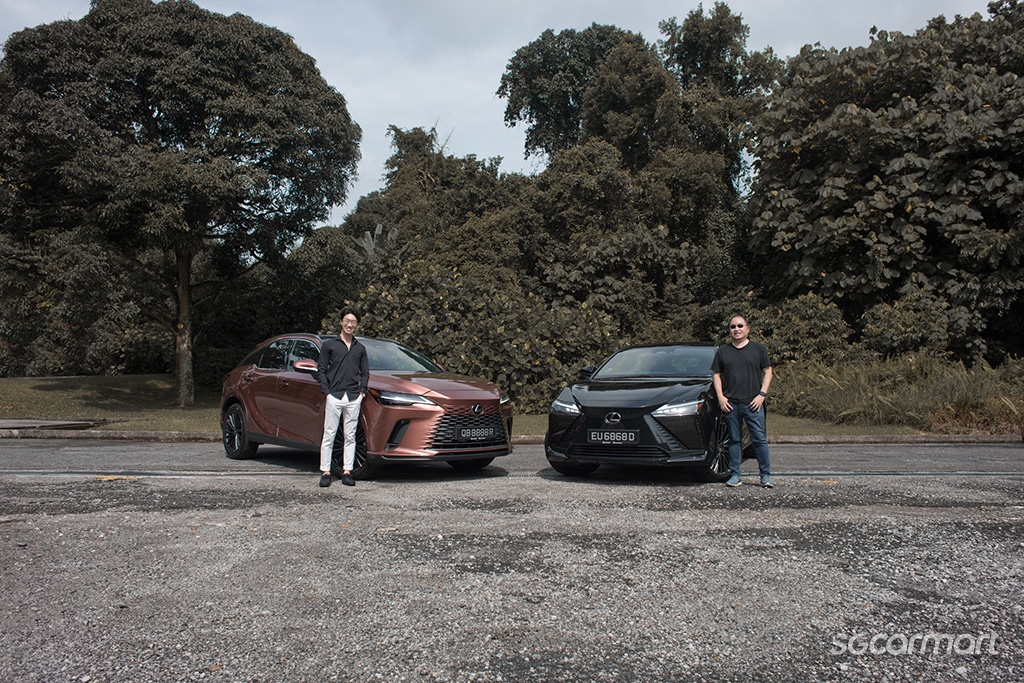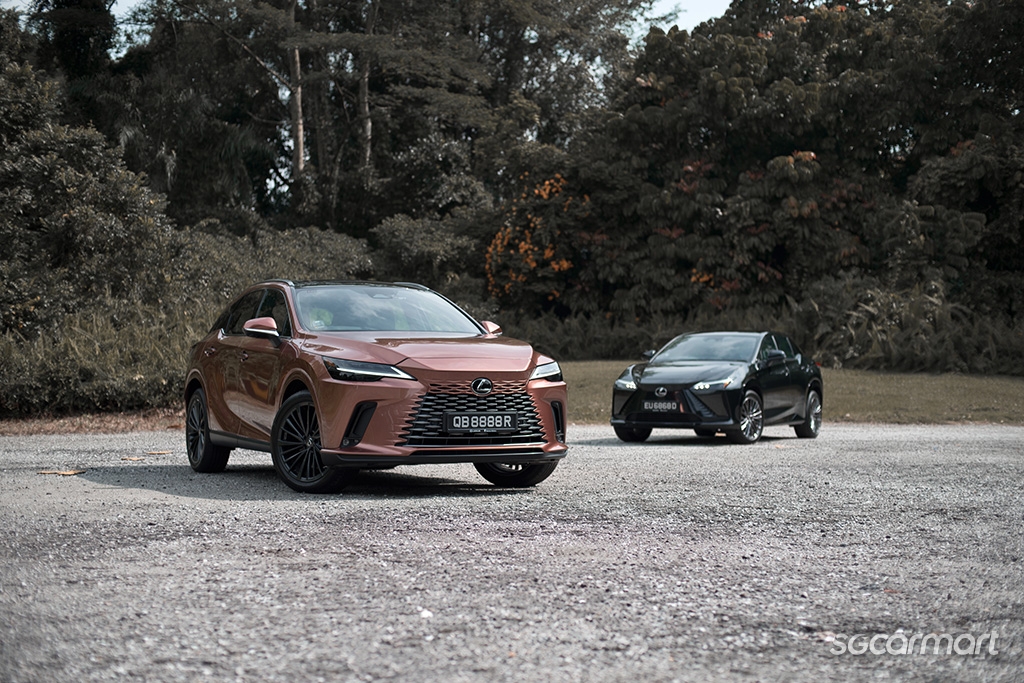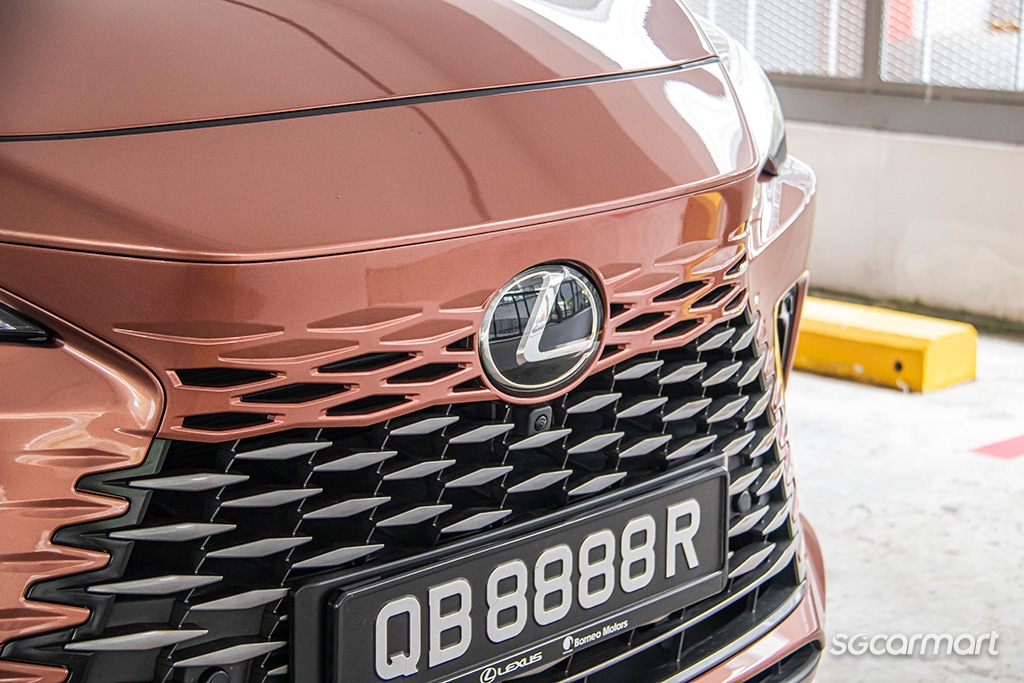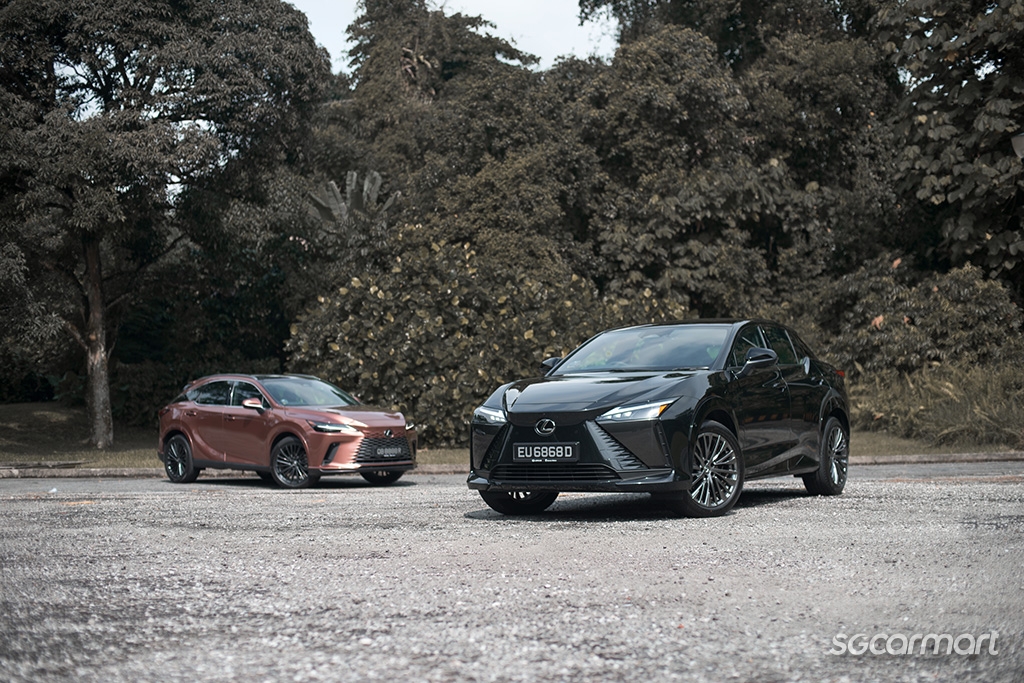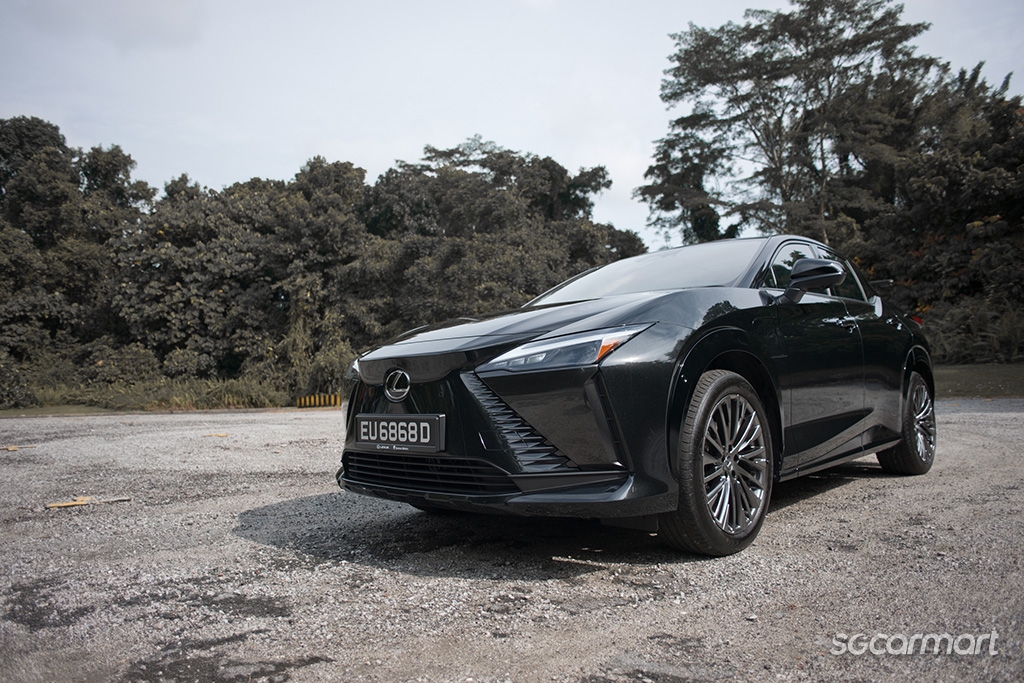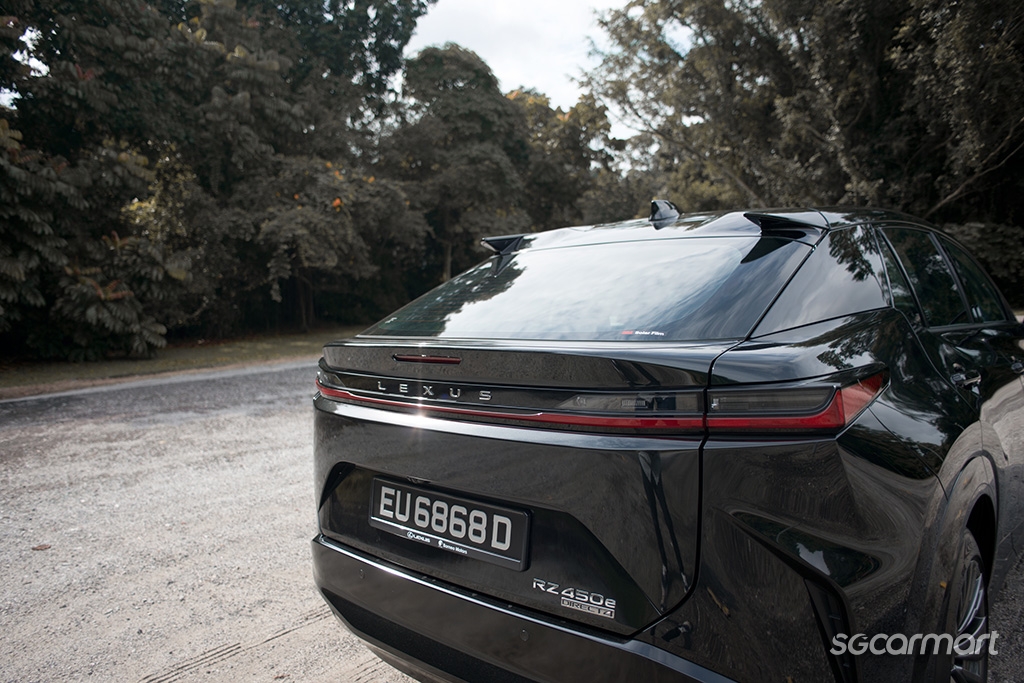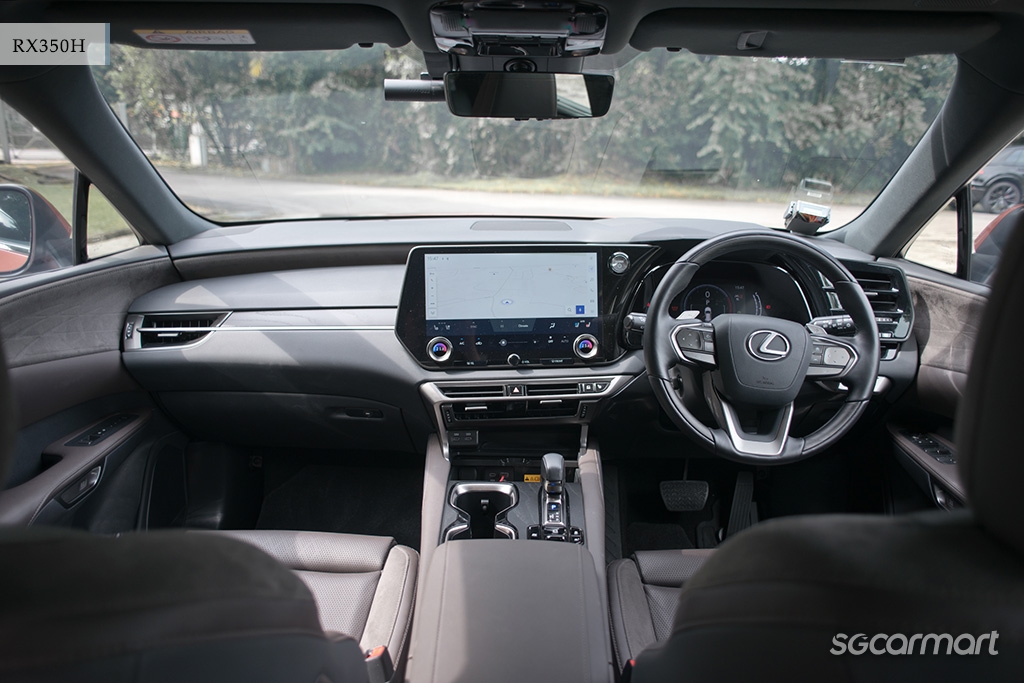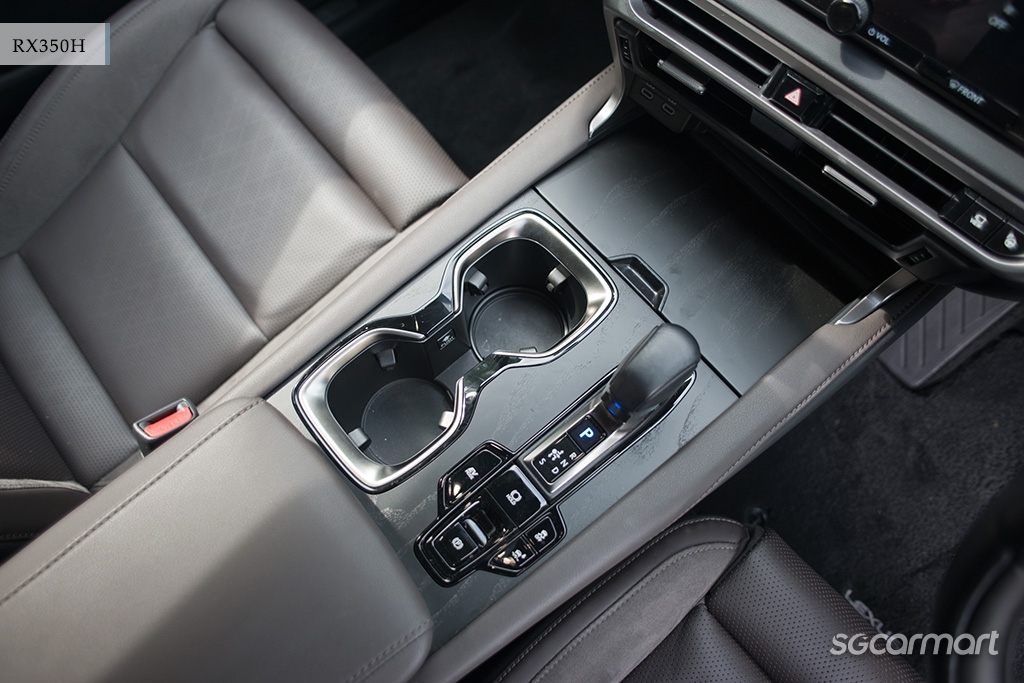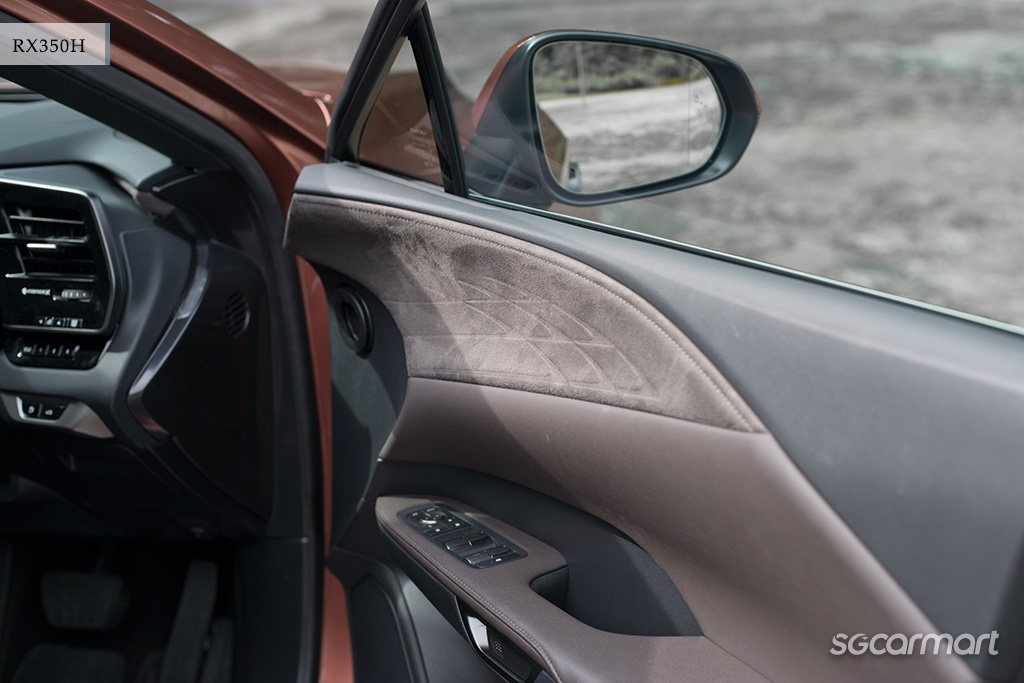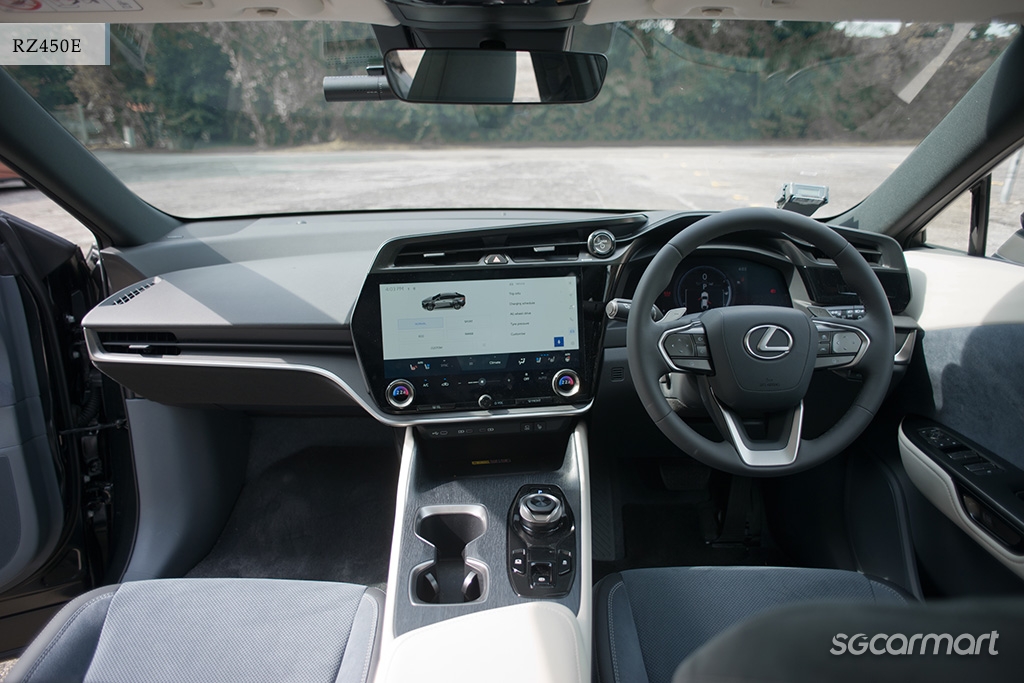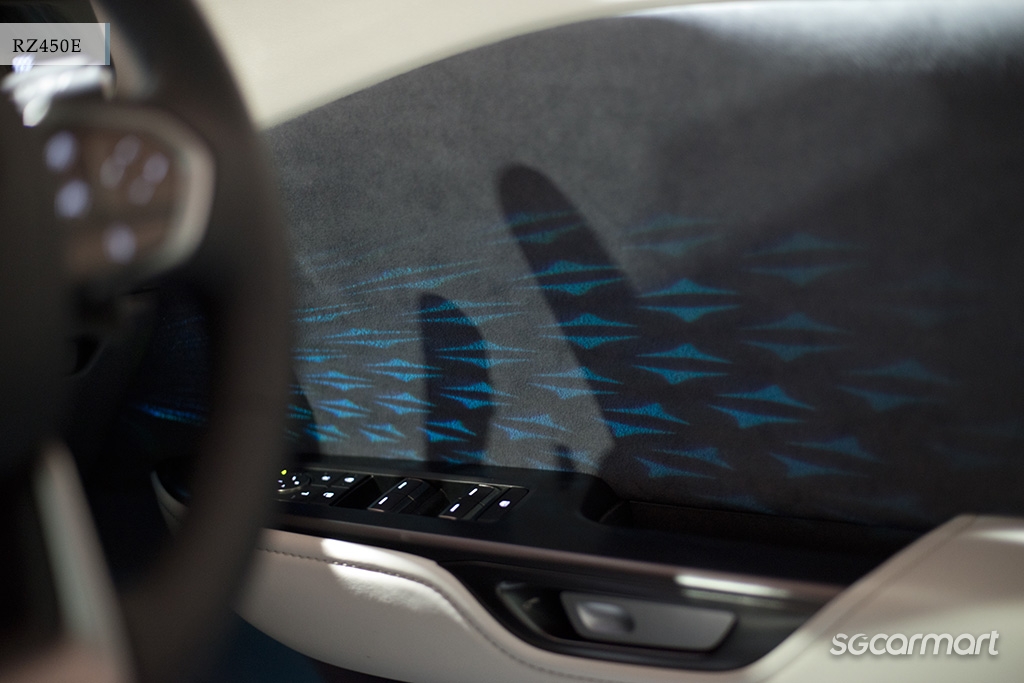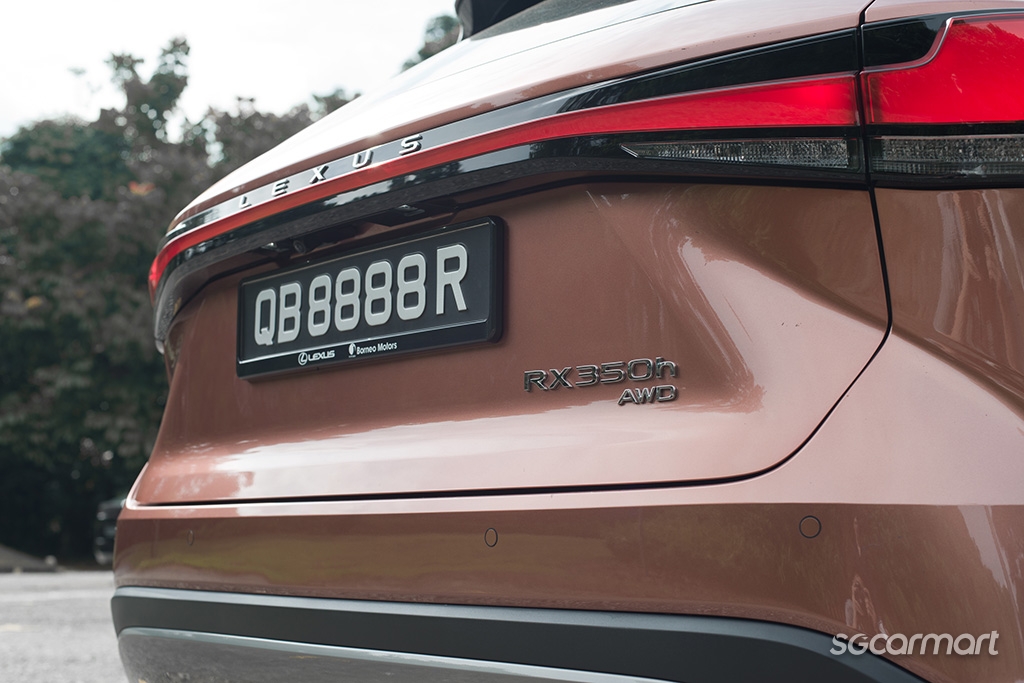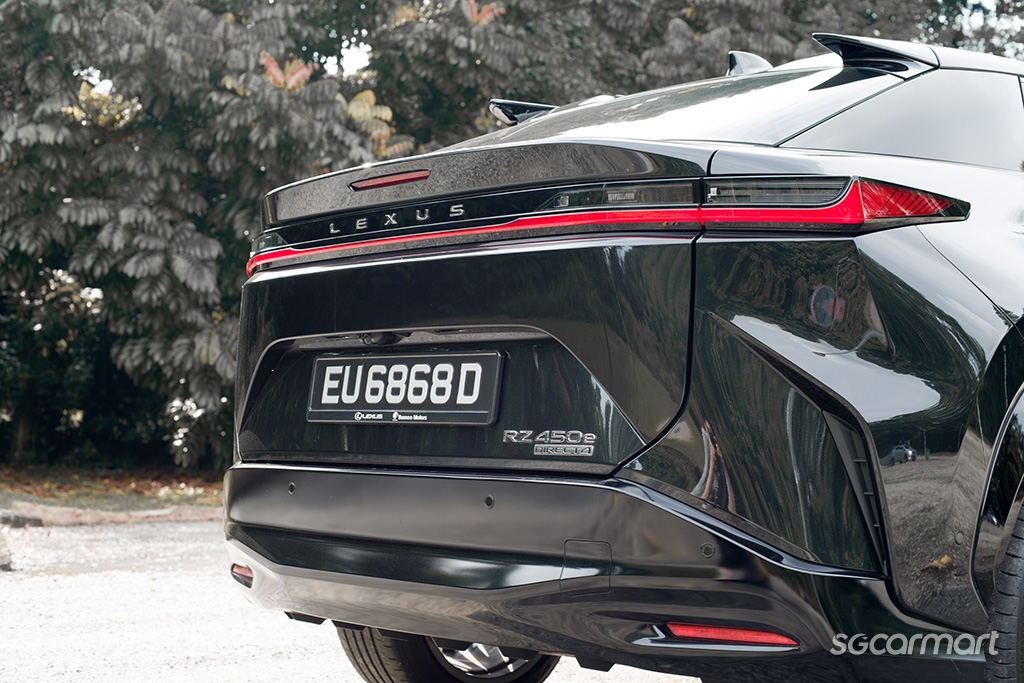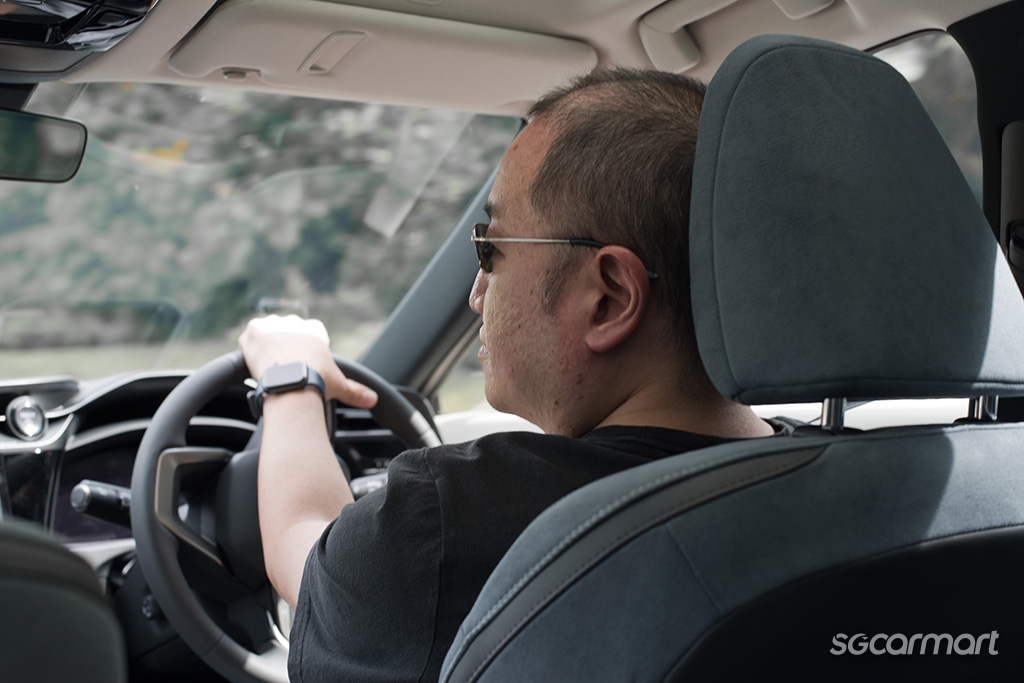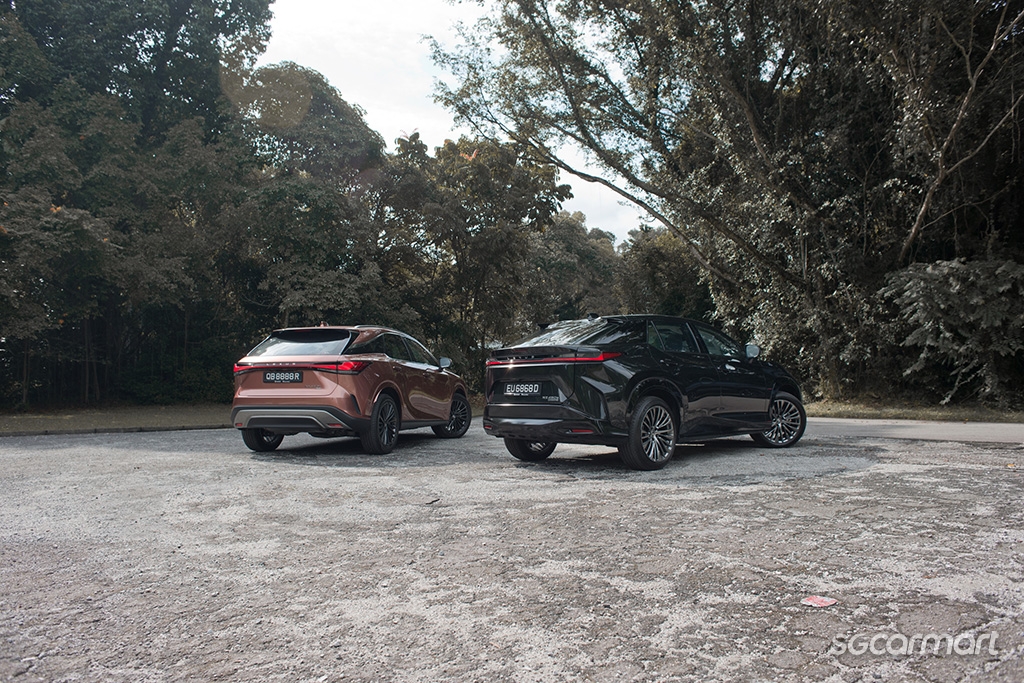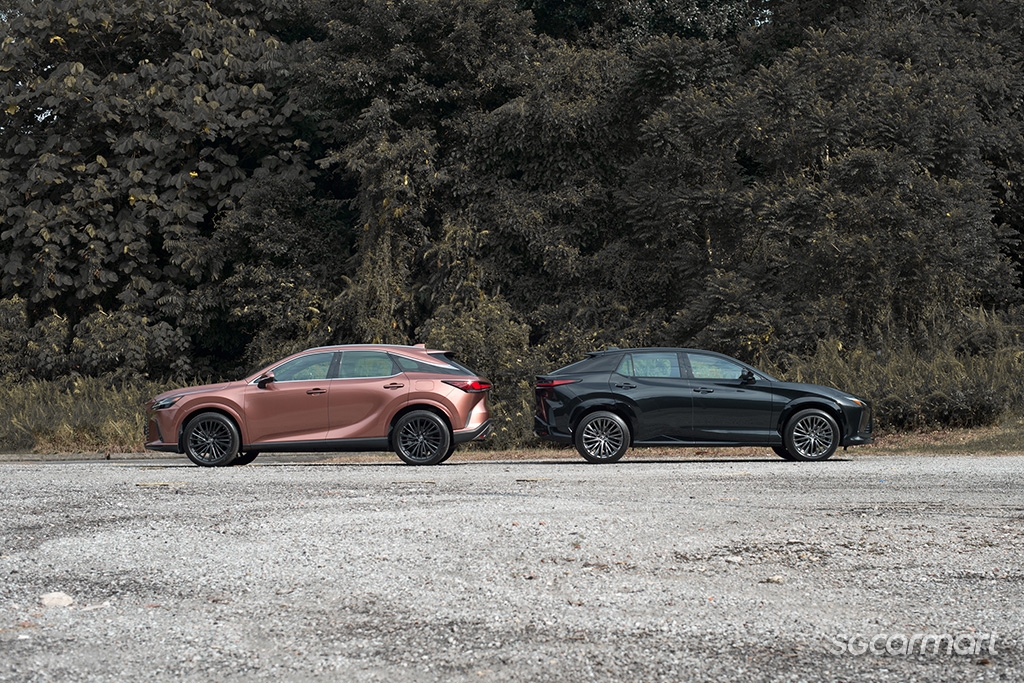Lexus RX vs RZ: Tale of two electri-cities
04 Jul 2023|1,989 views
Think Lexus, and the firm's 'takumi' masters immediately come to mind.
To drive, or even ride in a Lexus is to expect and receive the experience of being cosseted in an intricately-crafted, layered cabin. Pillowy and quiet rides are also par for the course. All this, of course, is tied together with the promise of bulletproof, good ole' Japanese reliability.
But that's not where Lexus has always excelled. Sure - the carmaker has perhaps always believed in moving to its own rhythm (and not entirely that of the market's), but in doing so, it's also been a quiet needle-mover in the luxury car-making sphere.
The two models we've gathered today are a testament to this. Arguably, the RX and RZ stand as two of the most important icons for the Lexus brand today - one already established, the other currently in the making. Nonetheless, which SUV best represents the essence of Lexus today? Here's where we start being less certain…
The past, present, and future of radiance
Matt:
It may be hard to keep pace with the relentless onslaught of new car names flooding our roads every now and then, but the letters ‘RX’ have long staked their unmistakable place firmly in the automotive world.
As one of the first bearers of the X moniker, the RX - meaning 'Radiant Crossover' - has since become not just a household name to the casual buyer, but also a 'core model' by the official words of Lexus.
If its predecessor traded soft subtlety for sharper angles with its 'Spindle Grille', the current RX finds a more balanced midpoint between the two.
It's not that the car no longer incorporates angularity, nor that it no longer looks muscular (in fact the opposite is true). Rather, there is a new element of fluidity and seamlessness, yet also aura of power in the RX today not previously associated with the model.
The devil is also in the details; note how the criss-cross openings on the grille gradually fill up to become a solid mass on the front grille - an acknowledgement of the fact that traditional grilles will disappear as cars go electric.
In all, it's a clear sign that the RX has been relentlessly refined and improved on, yet also persists in holding onto some continuity from and connection to its forebears - this is how the car most immediately enchants.
Jeremy:
Lexus is not a first-mover or pioneer when it comes to electric vehicles. For better or worse, the carmaker continued to offer petrol-electric hybrids while its competitors scrambled to launch EV models.
However, Japanese companies are known for being conservative, so naturally, Lexus took its time before introducing the UX300e, which arrived in Singapore in 2021. Although Lexus did a good job, the UX300e is the electric variant of the UX range, which also offers petrol and hybrid models.
The RZ, on the other hand, is Lexus' first dedicated electric model. That means it was designed and engineered from the ground up solely as an electric vehicle - there are no other powertrain options for it. 'RZ' stands for Radiant Zero, with Radiant following the RX, while Zero reflects that the car has zero tailpipe emissions.
Though it resembles the RX, you'll notice that the RZ actually looks sportier and more futuristic, with a sleeker and cleaner grille that's mostly blanked off. It also features a fastback-inspired tailgate with a short 'deck lid' to further distinguish it from the RX. And with that impossibly slim taillight (or taillights), the RZ's rear is instantly recognisable, too.
Sportier, more futuristic-looking, and more aerodynamic, the RZ doesn't have to follow a set playbook with its design as Lexus' first dedicated EV
As Lexus' first dedicated EV, it does not have to follow a set playbook. For instance, the RZ has no rear wiper, which shows a willingness to prioritise style over practicality. But there are no compromises when it comes to something as key as aerodynamics. The RZ's 0.28Cd is far better than the RX's 0.35Cd, which helps increase its driving range.
And with Lexus aiming to go all-electric by 2035, aerodynamics is something that it will have to keep enhancing, since it affects a car's efficiency and maximum range.
Matt:
It's no coincidence that everything looks neater than before as you settle into the cabin; Lexus' current Tazuna cockpit philosophy - the term translates to 'the reins of a horse' - is meant to eliminate distraction as you're on the road.
No - being ensconced in the soft materials here is an experience that is far from the rawness of horse-riding (at least on the surface). In effect, however, the intuitiveness in this latest interior-iteration cannot be denied.
As one settles into the driver's seat, they are not faced with a dashboard that yells for attention with dazzling colours or dashboard-covering screens.
Instead, everything is laid out orderly across the crisp 14-inch infotainment screen, sensibly retained physical buttons, and digital instrument cluster.
You even get a coloured heads-up display, paired to touch-activated buttons on the steering wheel that can be configured to shortcuts of your own preference. Of note is that this entire system is far better in usability than the notorious trackpads introduced one generation ago.
The black ash wood on the centre console matches that on the steering wheel, while front door panels get this criss-crossing velvet finish
Just because the details are quiet, however, does not mean that they are no less obsessive.
In 'Luxury' trim, a comforting mixture of suede and leather meets the backs of occupants as they settle into the seats. Just note how the black ash wood on the centre console matches that on the steering wheel; the criss-crossing patterns on the velvet-finished door panels also softly coo "expensive".
A suite of other towkay-certified touches can be found around the cabin - including a scrumptious full-length sunroof, and automated ventilated seats (even for rear passengers!). But most delightful are a new innovation - electronic handles, which are not just simple, but satisfying to use.
Jeremy:
Now, at first glance it might seem that the RZ's cabin is identical to the RX. After all, both models use the same instrument panel and 14-inch touchscreen for the infotainment. But look below the centre console and you'll see that it has a snazzy two-level layout, with enough room to put a medium sized bag or handbag.
In a nod to eco-friendliness, the seats are upholstered in Ultrasuede rather than leather. The RZ is clearly aimed at the progressive and eco-conscious, who wish to reduce their consumption of leather. Ultrasuede feels plush, and more importantly, does not trap heat like leather, so there won't be any 'burnt' bums even in our sweltering weather.
If the sun is a bother, the electronic dimming sunroof can be instructed to go from clear to translucent in a second. It's quicker than any powered blind system, and is a neat party trick to impress your friends, too. At night, the light projections on the door panels add flair to the cabin's atmosphere.
In terms of comfort, I'd say the RZ's backseat is even more enticing, since the floor here is nearly flat whereas the RX still has a sizeable floor protrusion. Without the need for a driveshaft to connect the front motor with the one on the rear axle, the neater packaging results in a roomier backseat, especially for the middle occupant.
Silence, a key Lexus strength, is even more apparent in the RZ. An electric motor is inherently quiet and has lesser vibrations compared to an internal combustion engine. But without the thrum and noise of an engine, other sounds and reverberations become more obvious.
Noise-control measures include acoustic glass fitted on the front and rear windows, foam coating on the bases of the front and centre pillars, vibration damping material in the roof panel, and a sealed bonnet opening. The latter prevents the outflow of air around the bonnet, which would otherwise create noise.
The RZ arguably has the quietest interior you could find in a modern Lexus.
Matt:
SUVs have traditionally been known for being brash, gas-guzzling machines. Lexus, however, has taken a more alternative approach for quite some time now.
As with the rest of the family, the RX nameplate was a soothsayer-cum-early adopter of sorts in that it had already brought electrification to the world of high-riders at the turn of the century.
The rewards are three-fold in the RX350h now. The first: Driving refinement. Lift off the brakes, lightly prod the accelerator pedal and this mean-looking machine will roll off with near silence. Traffic jams and relentless red lights suddenly become more palatable.
Sure, the RX350h relies on an E-CVT, so you're guaranteed to hear its engine if you want to rush it to the speed limit. But in the well-insulated cabin, the sound is more of a distant, far removed rumble than a grating drone. The RX's platform and body are also stiffer than before, resulting in far less vehicle lean.
But hurrying the RX along is not what you want to be doing anyway; the friendly mini-tank feels most comfortable when you treat it more as a limousine than a getaway car.
That brings us to benefit number two: Fuel consumption (or the lack thereof). For something that weighs 2.6 tonnes, we've consistently managed a real fuel economy in the range of 15km/L to 16km/L, even in instances of hustling the car around. Some compact hatchbacks don't even get to these figures.
And finally, there's the promise of zero lifestyle amendments considering its hybrid system is self-charging.
To those wanting to hang back as Singapore ramps up its charging station network - and unwieldy road tax system for EVs - here's a somewhat electric, somewhat green SUV that still allows for five-minute petrol station stops.
Jeremy:
I concede that charging an EV takes longer than filling your fuel tank. Owning an EV does necessitate a lifestyle change. If you have a charger at home, recharging the RZ is easy. You can also incorporate charging during the week, too, if there are chargers in places you frequent.
That said, if you've always wanted to own a luxurious electric SUV, there's no need to keep waiting for the charging network to further expand - it's already happening as you read this story.
As mentioned earlier, the RZ is powered by a dual motor system (one motor per axle) that effectively gives it all-wheel drive. It adjusts drive torque in response to factors such as wheel speed, acceleration and steering, such that all the driver feels is silky smooth, uninterrupted power delivery.
To ensure everyone's hairdos are unruffled, the car features Vehicle Braking Posture Control, which coordinates the front and rear energy regeneration. It helps deliver a linear braking feel.
When it comes to performance, the RZ is in a class of its own. The electric motors punch out 308bhp and 435Nm of torque, which can propel the SUV from a standstill to 100km/h in 5.3 seconds. Mind you, that's quicker than the range-topping RX500h F Sport Performance, which does this in 6.2 seconds.
The RZ is sublime. It barely emits a sound and if you do hear something, that's the brand's Active Sound Control at work. Engineers created a soundtrack to match the driving conditions like acceleration and braking, so the driver has audio feedback. Mostly, it'll just be you enjoying your music though.
Further enhancing the cabin's tranquil nature are the Frequency Reactive Dampers, which Lexus has improved. They respond to changes in road surface frequency by altering the damping force on the extension stroke, thereby enhancing both handling and ride quality.
The RZ doesn't just offer performance and refinement. It also delivers a linear and predictable drive, making it easy even for a first-timer to get the hang of.
In 2023, the RX will undoubtedly continue to attract the attention of most buyers (especially in Singapore) at the very first instance.
Lexus isn't one to take uncalculated risks, but in hybrid form today, this 'core model'-SUV represents a well-honed culmination of decades of cabin-crafting, car-building expertise.
Don't write the RZ off, however. If the RX represents the path thus far, the RZ can be taken as a beacon for the future.
Sure, it may have taken a while for it to come to the market. But it embodies the very core of Lexus' measured manner of doing things, which, in turn, has undeniably held appeal for decades.
Lexus has done a fantastic job of staying true to itself. The two roots of the brand are here - silence and silkiness - and even with its charged-up powertrain, the RZ remembers to deliver not just raw, unbridled power, but power in just the amount that Lexus thinks you'll like.
What this means to us, then, is that Lexus is still laser-focused on what has made it successful, even as it readies itself for the big shift. Present or future; electric or electrified - both the RX and RZ reassure that the brand is on the right track.
Here are a few other stories that may interest you!
BMW i7 and BMW 7 Series: Best brothers
Modern seven-seaters: The SUV or the MPV?
Is the Mercedes S-Class as compelling as the all-electric EQS?
Think Lexus, and the firm's 'takumi' masters immediately come to mind.
To drive, or even ride in a Lexus is to expect and receive the experience of being cosseted in an intricately-crafted, layered cabin. Pillowy and quiet rides are also par for the course. All this, of course, is tied together with the promise of bulletproof, good ole' Japanese reliability.
But that's not where Lexus has always excelled. Sure - the carmaker has perhaps always believed in moving to its own rhythm (and not entirely that of the market's), but in doing so, it's also been a quiet needle-mover in the luxury car-making sphere.
The two models we've gathered today are a testament to this. Arguably, the RX and RZ stand as two of the most important icons for the Lexus brand today - one already established, the other currently in the making. Nonetheless, which SUV best represents the essence of Lexus today? Here's where we start being less certain…
The past, present, and future of radiance
Matt:
It may be hard to keep pace with the relentless onslaught of new car names flooding our roads every now and then, but the letters ‘RX’ have long staked their unmistakable place firmly in the automotive world.
As one of the first bearers of the X moniker, the RX - meaning 'Radiant Crossover' - has since become not just a household name to the casual buyer, but also a 'core model' by the official words of Lexus.
If its predecessor traded soft subtlety for sharper angles with its 'Spindle Grille', the current RX finds a more balanced midpoint between the two.
It's not that the car no longer incorporates angularity, nor that it no longer looks muscular (in fact the opposite is true). Rather, there is a new element of fluidity and seamlessness, yet also aura of power in the RX today not previously associated with the model.
The devil is also in the details; note how the criss-cross openings on the grille gradually fill up to become a solid mass on the front grille - an acknowledgement of the fact that traditional grilles will disappear as cars go electric.
In all, it's a clear sign that the RX has been relentlessly refined and improved on, yet also persists in holding onto some continuity from and connection to its forebears - this is how the car most immediately enchants.
Jeremy:
Lexus is not a first-mover or pioneer when it comes to electric vehicles. For better or worse, the carmaker continued to offer petrol-electric hybrids while its competitors scrambled to launch EV models.
However, Japanese companies are known for being conservative, so naturally, Lexus took its time before introducing the UX300e, which arrived in Singapore in 2021. Although Lexus did a good job, the UX300e is the electric variant of the UX range, which also offers petrol and hybrid models.
The RZ, on the other hand, is Lexus' first dedicated electric model. That means it was designed and engineered from the ground up solely as an electric vehicle - there are no other powertrain options for it. 'RZ' stands for Radiant Zero, with Radiant following the RX, while Zero reflects that the car has zero tailpipe emissions.
Though it resembles the RX, you'll notice that the RZ actually looks sportier and more futuristic, with a sleeker and cleaner grille that's mostly blanked off. It also features a fastback-inspired tailgate with a short 'deck lid' to further distinguish it from the RX. And with that impossibly slim taillight (or taillights), the RZ's rear is instantly recognisable, too.
Sportier, more futuristic-looking, and more aerodynamic, the RZ doesn't have to follow a set playbook with its design as Lexus' first dedicated EV
As Lexus' first dedicated EV, it does not have to follow a set playbook. For instance, the RZ has no rear wiper, which shows a willingness to prioritise style over practicality. But there are no compromises when it comes to something as key as aerodynamics. The RZ's 0.28Cd is far better than the RX's 0.35Cd, which helps increase its driving range.
And with Lexus aiming to go all-electric by 2035, aerodynamics is something that it will have to keep enhancing, since it affects a car's efficiency and maximum range.
Matt:
It's no coincidence that everything looks neater than before as you settle into the cabin; Lexus' current Tazuna cockpit philosophy - the term translates to 'the reins of a horse' - is meant to eliminate distraction as you're on the road.
No - being ensconced in the soft materials here is an experience that is far from the rawness of horse-riding (at least on the surface). In effect, however, the intuitiveness in this latest interior-iteration cannot be denied.
As one settles into the driver's seat, they are not faced with a dashboard that yells for attention with dazzling colours or dashboard-covering screens.
Instead, everything is laid out orderly across the crisp 14-inch infotainment screen, sensibly retained physical buttons, and digital instrument cluster.
You even get a coloured heads-up display, paired to touch-activated buttons on the steering wheel that can be configured to shortcuts of your own preference. Of note is that this entire system is far better in usability than the notorious trackpads introduced one generation ago.
The black ash wood on the centre console matches that on the steering wheel, while front door panels get this criss-crossing velvet finish
Just because the details are quiet, however, does not mean that they are no less obsessive.
In 'Luxury' trim, a comforting mixture of suede and leather meets the backs of occupants as they settle into the seats. Just note how the black ash wood on the centre console matches that on the steering wheel; the criss-crossing patterns on the velvet-finished door panels also softly coo "expensive".
A suite of other towkay-certified touches can be found around the cabin - including a scrumptious full-length sunroof, and automated ventilated seats (even for rear passengers!). But most delightful are a new innovation - electronic handles, which are not just simple, but satisfying to use.
Jeremy:
Now, at first glance it might seem that the RZ's cabin is identical to the RX. After all, both models use the same instrument panel and 14-inch touchscreen for the infotainment. But look below the centre console and you'll see that it has a snazzy two-level layout, with enough room to put a medium sized bag or handbag.
In a nod to eco-friendliness, the seats are upholstered in Ultrasuede rather than leather. The RZ is clearly aimed at the progressive and eco-conscious, who wish to reduce their consumption of leather. Ultrasuede feels plush, and more importantly, does not trap heat like leather, so there won't be any 'burnt' bums even in our sweltering weather.
If the sun is a bother, the electronic dimming sunroof can be instructed to go from clear to translucent in a second. It's quicker than any powered blind system, and is a neat party trick to impress your friends, too. At night, the light projections on the door panels add flair to the cabin's atmosphere.
In terms of comfort, I'd say the RZ's backseat is even more enticing, since the floor here is nearly flat whereas the RX still has a sizeable floor protrusion. Without the need for a driveshaft to connect the front motor with the one on the rear axle, the neater packaging results in a roomier backseat, especially for the middle occupant.
Silence, a key Lexus strength, is even more apparent in the RZ. An electric motor is inherently quiet and has lesser vibrations compared to an internal combustion engine. But without the thrum and noise of an engine, other sounds and reverberations become more obvious.
Noise-control measures include acoustic glass fitted on the front and rear windows, foam coating on the bases of the front and centre pillars, vibration damping material in the roof panel, and a sealed bonnet opening. The latter prevents the outflow of air around the bonnet, which would otherwise create noise.
The RZ arguably has the quietest interior you could find in a modern Lexus.
Matt:
SUVs have traditionally been known for being brash, gas-guzzling machines. Lexus, however, has taken a more alternative approach for quite some time now.
As with the rest of the family, the RX nameplate was a soothsayer-cum-early adopter of sorts in that it had already brought electrification to the world of high-riders at the turn of the century.
The rewards are three-fold in the RX350h now. The first: Driving refinement. Lift off the brakes, lightly prod the accelerator pedal and this mean-looking machine will roll off with near silence. Traffic jams and relentless red lights suddenly become more palatable.
Sure, the RX350h relies on an E-CVT, so you're guaranteed to hear its engine if you want to rush it to the speed limit. But in the well-insulated cabin, the sound is more of a distant, far removed rumble than a grating drone. The RX's platform and body are also stiffer than before, resulting in far less vehicle lean.
But hurrying the RX along is not what you want to be doing anyway; the friendly mini-tank feels most comfortable when you treat it more as a limousine than a getaway car.
That brings us to benefit number two: Fuel consumption (or the lack thereof). For something that weighs 2.6 tonnes, we've consistently managed a real fuel economy in the range of 15km/L to 16km/L, even in instances of hustling the car around. Some compact hatchbacks don't even get to these figures.
And finally, there's the promise of zero lifestyle amendments considering its hybrid system is self-charging.
To those wanting to hang back as Singapore ramps up its charging station network - and unwieldy road tax system for EVs - here's a somewhat electric, somewhat green SUV that still allows for five-minute petrol station stops.
Jeremy:
I concede that charging an EV takes longer than filling your fuel tank. Owning an EV does necessitate a lifestyle change. If you have a charger at home, recharging the RZ is easy. You can also incorporate charging during the week, too, if there are chargers in places you frequent.
That said, if you've always wanted to own a luxurious electric SUV, there's no need to keep waiting for the charging network to further expand - it's already happening as you read this story.
As mentioned earlier, the RZ is powered by a dual motor system (one motor per axle) that effectively gives it all-wheel drive. It adjusts drive torque in response to factors such as wheel speed, acceleration and steering, such that all the driver feels is silky smooth, uninterrupted power delivery.
To ensure everyone's hairdos are unruffled, the car features Vehicle Braking Posture Control, which coordinates the front and rear energy regeneration. It helps deliver a linear braking feel.
When it comes to performance, the RZ is in a class of its own. The electric motors punch out 308bhp and 435Nm of torque, which can propel the SUV from a standstill to 100km/h in 5.3 seconds. Mind you, that's quicker than the range-topping RX500h F Sport Performance, which does this in 6.2 seconds.
The RZ is sublime. It barely emits a sound and if you do hear something, that's the brand's Active Sound Control at work. Engineers created a soundtrack to match the driving conditions like acceleration and braking, so the driver has audio feedback. Mostly, it'll just be you enjoying your music though.
Further enhancing the cabin's tranquil nature are the Frequency Reactive Dampers, which Lexus has improved. They respond to changes in road surface frequency by altering the damping force on the extension stroke, thereby enhancing both handling and ride quality.
The RZ doesn't just offer performance and refinement. It also delivers a linear and predictable drive, making it easy even for a first-timer to get the hang of.
In 2023, the RX will undoubtedly continue to attract the attention of most buyers (especially in Singapore) at the very first instance.
Lexus isn't one to take uncalculated risks, but in hybrid form today, this 'core model'-SUV represents a well-honed culmination of decades of cabin-crafting, car-building expertise.
Don't write the RZ off, however. If the RX represents the path thus far, the RZ can be taken as a beacon for the future.
Sure, it may have taken a while for it to come to the market. But it embodies the very core of Lexus' measured manner of doing things, which, in turn, has undeniably held appeal for decades.
Lexus has done a fantastic job of staying true to itself. The two roots of the brand are here - silence and silkiness - and even with its charged-up powertrain, the RZ remembers to deliver not just raw, unbridled power, but power in just the amount that Lexus thinks you'll like.
What this means to us, then, is that Lexus is still laser-focused on what has made it successful, even as it readies itself for the big shift. Present or future; electric or electrified - both the RX and RZ reassure that the brand is on the right track.
Here are a few other stories that may interest you!
BMW i7 and BMW 7 Series: Best brothers
Modern seven-seaters: The SUV or the MPV?
Is the Mercedes S-Class as compelling as the all-electric EQS?
Thank You For Your Subscription.


























